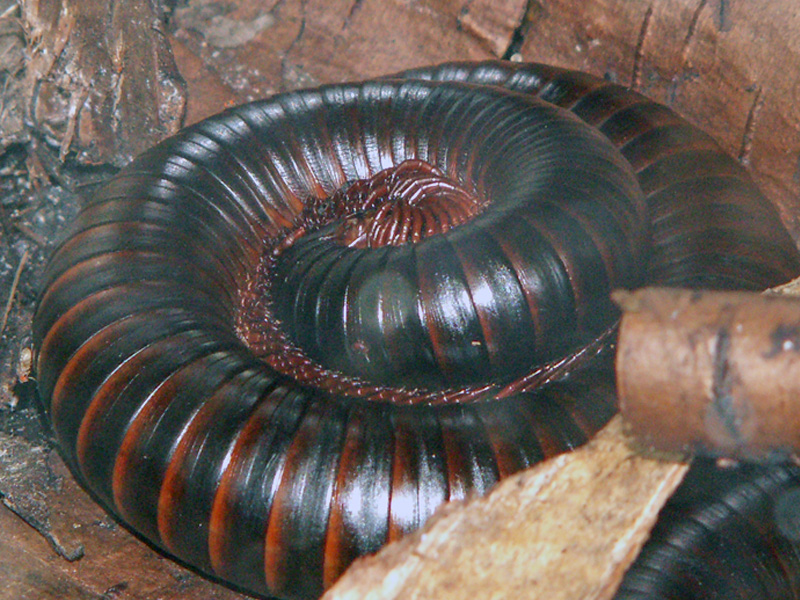
Giant African millipede(Archispirostreptus gigas)
Phylum —arthropoda
Class —diplopoda
Order —spirostreptida
Family —spirostreptidae
Genus – archispirostreptus
Appearance
It is the largest extant species of millipede, growing up to 33.5 centimeters (13.2 in) in length, 67 millimeters (2.6 in) in circumference. It has approximately 256 legs, although the number of legs changes with each molting so it can vary according to each individual.
It has a multicolored body ranging from almost black to mahogany. The inner rings are lighter and contrasting in color, often shades of orange and sometimes reddish. The legs and antennae are usually mahogany to rusty brown in color.
Habitat
It is a widespread species in lowland parts of East Africa, from Mozambique to Kenya, but rarely reaches altitudes above 1,000 meters (3,300 ft). It lives mostly in forests, but can also be found in areas of coastal habitat that contain at least a few trees. It is native to Southern Arabia, especially Dhofar.
Behavior
Giant African millipedes have two main modes of defense if they feel threatened: curling into a tight spiral exposing only the hard exoskeleton, and secretion of an irritating liquid from pores on their body. This liquid can be harmful if introduced into the eyes or mouth. Because of this defense, Archispirostreptusgigasis one of the few invertebrates that driver ants are incapable of taking as prey.
Small mites are often observed crawling on their exoskeleton and among their legs. The millipedes have a symbiotic relationship with these mites, in which the mites help clean the millipede's exoskeleton in exchange for food and the protection of their host.
Diet
This millipede feeds on the constituents of the substrate.
Reproduction
Mating is conducted face to face; the pair often remaining coupled for long periods. Giant African millipedes usually lay 3mm light yellow eggs a few inches deep in the substrate from September to November. The eggs hatch after about 6 weeks.
This is a slow growing species. After 6 months it is light grey and about 2cm long, getting darker with successive moults.After 2 years it is dark brown and 8 to 11cm long. Adult – after about 5 years and can live another 5 years as adult.
In captivity
In general, Giant African millipedeshave a life expectancy of about 7–10 years.
These animals are very robust and do not cause any problems even for beginners.
House singularly or in groups, in large and secure plastic tanks or glass terrariums.Provide a deep soil based substrate layer of 7-10cm which is enriched with natural organic matter. Add natural decor such as bark and branches for enrichment and cover. Sphagnum moss can also use for helping maintain humidity.
This species is tolerant of some temperature fluctuation, but try to maintain them between 24°C (75°F) and 26°C (79°F) using appropriate terrarium heating equipment. Maintain a moderate level of humidity around 70-80% with frequent misting, using a hand or pump sprayer.
The BIG SECRET of keeping and breeding millipedes is DON'T DISTURB THEM. Now this means that if they vanish out of sight for a few days which is what they tend to do, don't dig them up to check on them. Millipedes are naturally subterranean and so spend some time out of sight.
Millipedes feed on soft fruits and vegetables and show a great fondness for cucumber it's always best to offer a mixture of foods, dusted with extra calcium; this simply means scraping some cuttlefish over your food stuffs. Also remove the food before it moulds usually the next day but do leave it in through at least one night.
 Russian
Russian
 English
English
























